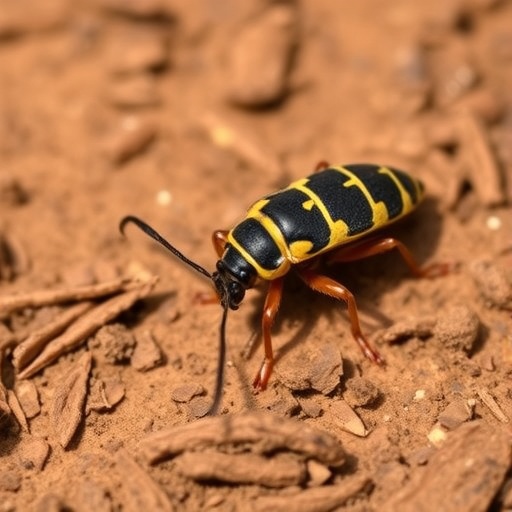
The agricultural landscape of South Africa is increasingly troubled by the dramatic emergence of the fall armyworm (Spodoptera frugiperda), an invasive pest with the potential to devastate crops critical to food security and local economies. A new study published in Discover Agriculture by researchers T.D. Raphela and M. Mafadza signals an urgent call to action for subsistence farmers in the Limpopo Province, where the ramifications of this pest threaten to spiral out of control. The research underscores the dual nature of the impact of fall armyworm infestation; it does not only harm the immediate crop yields but also jeopardizes the income and livelihoods of farmers who are already working within precarious economic parameters.
The study highlights how the fall armyworm utilizes a range of crops, notably maize, which is a staple food in many South African households. This migratory pest is characterized by its rapid lifecycle and ability to reproduce at a staggering rate, which creates an escalating threat to agricultural production. Farmers, particularly those in rural areas, often lack the resources and knowledge necessary to effectively manage pest attacks. This has led to an alarming increase in crop damage and subsequent financial losses for subsistence farmers who rely heavily on maize for both consumption and income.
Among the various factors that contribute to the vulnerability of farmers in the Limpopo Province is the widespread lack of knowledge regarding integrated pest management strategies. The researchers identified a significant gap in educational outreach pertaining to pest control. Many farmers are unaware of sustainable practices that could potentially mitigate the impact of the fall armyworm. Without formal training and resources, these families find themselves resorting to unsustainable practices that only exacerbate the problem.
Another significant barrier is the limited access to financial resources needed to implement effective pest management programs. With agriculture being a primary source of income for many in the area, loss of crops due to infestations can result in dire consequences, pushing already struggling families further into poverty. This situation creates a vicious cycle where limited income prevents farmers from investing in their own productivity, ultimately resulting in a decrease in food security not only for their families but for the larger community as well.
The fall armyworm isn’t merely a pest; it is a catalyst for broader socio-economic challenges affecting subsistence farms. The invasive nature of this pest highlights the interconnectedness of environmental health and community well-being. As pest populations grow unchecked, the implications extend beyond agriculture, adversely affecting nutrition, education, and public health. Farmers are left grappling with a dual crisis—combating a burgeoning pest while managing limited resources for their families.
Throughout their research, Raphela and Mafadza emphasized that collaboration between local governments, agricultural organizations, and the farmers themselves is imperative. Such partnerships could facilitate the dissemination of critical information about sustainable farming practices and integrated pest management. Workshops, training sessions, and the distribution of educational materials could empower farmers, equipping them with the tools they need to combat the fall armyworm and safeguard their livelihoods.
Additionally, the utilization of technology could play a pivotal role in early detection and monitoring of fall armyworm infestations. Mobile applications and other digital resources could enable farmers to share information quickly and efficiently, fostering a community-driven approach to pest management. Collective intelligence could lead to the development of localized solutions, tailored to the specific needs and conditions of their farms.
The study also underscores the role of government policy in addressing pest-related challenges. Strategic investments in research and development for effective pest control methods will be essential for building resilience within communities. Furthermore, establishing frameworks for monitoring pest populations and predicting their movements could greatly assist farmers in anticipating and preparing for infestations before they devastate crops.
Moreover, the political will to allocate resources toward agricultural education and pest management is critical. Building robust extension services that provide the necessary information and support to farmers can lead to long-term benefits for food security. Such initiatives must recognize the unique socio-economic landscapes within which these farmers operate, catering to their specific needs and challenges.
As the fall armyworm continues to wreak havoc on crops across the region, the time for action is now. The stark evidence presented by Raphela and Mafadza serves as a wake-up call indicating that the fallout from this pest poses a substantial risk not just to the agricultural sector but to societal stability as a whole. The consequences of inaction will resonate far beyond the immediate impact of crop failure, potentially leading to exacerbated poverty, malnutrition, and associated health issues.
In conclusion, the impact of fall armyworm infestations on subsistence farmers in Limpopo Province is a multifaceted issue that requires urgent attention. Stakeholders must come together to address the challenges posed by this invasive pest, focusing on education, collaboration, and policy reform. Only through concerted efforts can we hope to mitigate the effects of fall armyworm and secure a more sustainable agricultural future for those who depend on it most.
Subject of Research: Impact of fall armyworm on subsistence farmers in the Limpopo Province, South Africa
Article Title: The impact of fall armyworm on subsistence farmers in the Limpopo Province of South Africa.
Article References:
Raphela, T.D., Mafadza, M. The impact of fall armyworm on subsistence farmers in the Limpopo Province of South Africa. Discov Agric 3, 133 (2025). https://doi.org/10.1007/s44279-025-00316-2
Image Credits: AI Generated
DOI: 10.1007/s44279-025-00316-2
Keywords: fall armyworm, subsistence farmers, Limpopo Province, South Africa, pest management, food security, agricultural sustainability, socio-economic challenges.
Tags: Agricultural pest management strategiesagricultural research in South Africacrop yield threats in Limpopoeconomic effects of fall armywormfall armyworm impact on agriculturefood security and farminginvasive pests in South AfricaLimpopo Province farming challengesmaize crop destructionpest control knowledge gapsrural farming sustainability issuessubsistence farmers income loss




